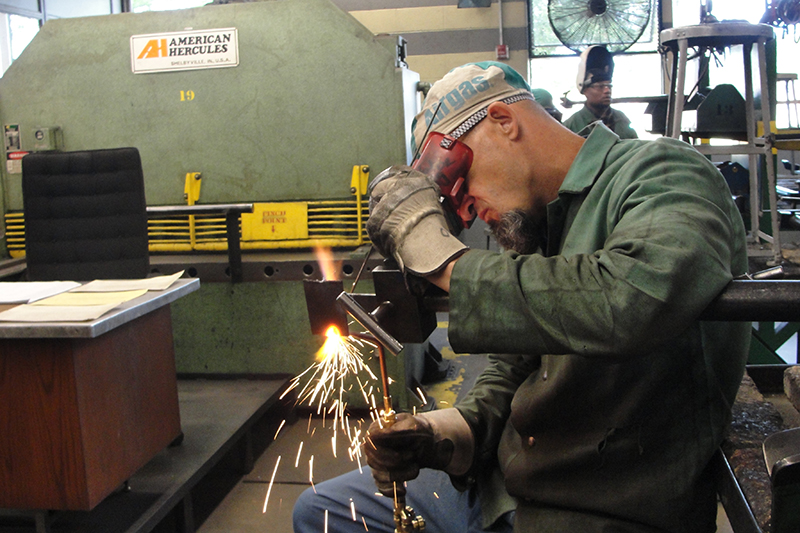- Federal Prison Programs For Inmates
- Inmate Work Program Florida
- RCW 28A.193.020 Solicitation For Education Provider – Selection Of Provider – Operation Of Program By Educational Service District. Regarding The Solicitation Of An Educational Provider For The Dep...
An inmate’s SCI security level is also assigned during this process. DOC offers many programs to address an inmate’s treatment needs. The various SCI programs offered are explained. Alcohol and Other Drugs (AOD) Treatment Programs. Note: TCU is the Texas Christian University Drug Screen. Outpatient Program: medium to high risk inmates TCU. Work Programs Sentenced inmates are required to work if they are medically able. Institution work assignments include employment in areas like food service or the warehouse, or work as an inmate orderly, plumber, painter, or groundskeeper. Inmates earn 12¢ to 40¢ per hour for these work assignments. Unless precluded by law or Department regulation, in general people in prison are eligible for the Transitional Work Program up to four years prior to their discharge date. There are some instances in which an imprisoned person’s eligibility is limited to the 6 months or 12 months of his or her incarceration, based on his or her offense. The video above demonstrates the variety of work inmates can perform for state agencies, local governments and private sector partners. For more information on inmate labor, please visit the information page for Arizona Correctional Industries or call Offender Operations Division at (602) 542-3894.
September 27, 2016
Providing rehabilitation for inmates offers countless benefits to the individual inmate as well as the community that inmate will re-enter upon his or her release.
The options for rehabilitation for inmates vary by facility, offense, and sentence length. Just like the cause of incarceration varies by inmate, the type of rehabilitation an inmate might respond to can also vary.
(Note: To learn about your loved one’s rehabilitation options, please contact their correctional facility directly and request more information.)
Some inmates may benefit from multiple kinds of rehabilitation. We put together a list of five of the most rewarding types of rehabilitation for inmates below.
1. Education Rehabilitation for Inmates
It has been proven time and time again that education programs in prison help to give inmates a second chance. In fact, inmates who participated in educational programs were 43% less likely to commit a crime and return to incarceration within three years than those who did not.
The statistics proving the value behind providing education programs in prison have helped change the landscape of educational offerings for inmates.
Federal Prison Programs For Inmates
Positive outcomes for inmates who leave prison more educated than when they entered filter down into the community.
The extended family benefits, the local economy benefits when the ex-offender returns to work, and the taxpayers benefit when less people are incarcerated.

This, among other data, prompted President Obama to institute The Second Chance Pell Pilotwhich will open up the opportunity for about 12,000 inmates to apply for Pell grants for the first time in nearly 24 years.
Oftentimes these inmate education programs cover functional skills (above and beyond traditional academic programs).
For example, inmates who haven’t had access to a computer or the internet in many years are at a disadvantage when attempting to return to the workforce. Computer training programs have become a crucial piece of re-entry educational programs.
Education programs in prison are helping give the power of knowledge to inmates. With this power, overcoming the past and enjoying a better quality of life are two very achievable goals.
2. Employment Rehabilitation for Inmates
Inmates who have the opportunity to engage in prison work programs while incarcerated have an easier time getting work once they are released.
The inability to find and maintain work is a main factor in recidivism across the nation. When former inmates re-enter society without marketable skills, a domino effect occurs that often times leads to new offenses.
Breaking the cycle relies on becoming a productive member of society through gainful employment. Being able to support oneself is beneficial financially and mentally.
For a person newly re-entering society, the self-esteem and fulfillment that can come from working hard plays a big role in lessening criminal behavior.
During prison, many inmates are given an opportunity to participate in work programs. These programs offer a consistent way to prepare for work in society. Punctuality, responsibility, deadlines, accountability and other skills are learned through taking part.
The benefits of prison work programs go much deeper than just job training.
3. Counseling Rehabilitation for Inmates
Prison Counselors play a significant role in rehabilitation for inmates. These criminal justice and mental health professionals provide guidance to inmates throughout the duration of their sentence.
The support a Prison Counselor provides will range by inmate. Most counselors can offer hands on counseling covering the following topics:
- vocational
- academic
- social
- personal
The goal is to provide rehabilitation for inmates that will help them consider new skills and new insight into their goals and motivations.
Additionally, inmates can seek counseling on issues like depression, stress or substance abuse. Sometimes this may come in a group form, or one on one.
In addition to the support provided by the staff, counseling for inmates can be obtained through many non-profit organizations.
For example, The Lionheart Foundation program offers prison inmates “encouragement and the necessary support to take stock of the life experiences that have propelled them into criminal activity, take responsibility for their criminal behavior, change lifelong patterns of violence and addiction, and build productive lives.”
This organization trains counselors, chaplains, volunteers and others to visit prisons and provide counseling services. Their work extends into youth prisons and the community as well.
Taking advantage of the counseling offered during prison is a positive step towards rehabilitation.
4. Wellness Rehabilitation for Inmates
Physical and mental wellness bring clarity and purpose to many inmates during their sentence.
Depending on the offerings in an individual facility, an inmate may be able to participate in programs like yoga, tai chi, or meditation. Practicing these kinds of mental and physical exercises are proven to provide long term benefits including stress/anger management among others.
Positivity can be a difficult trait to maintain during a prison sentence, but some prisons are offering programs to help bring a positive light into an inmate’s life. Programs like dog training, culinary classes, gardening and more offer inmates opportunities to practice fulfilling skills that make a measurable difference.
Inmate Work Program Florida
Making good nutrition choices with meals in prison can also be difficult. But with effort, a healthy diet can also be maintained.
5. Community Rehabilitation for Inmates
Rehabilitation for inmates continues throughout an inmate’s life, even after they have left the system. Re-entering society and taking steps to join the community is a necessary piece of the rehabilitation process.
Adjusting to life after prison successfully has many variables. Having a support system within the community helps an ex-offender stay an ex-offender.
Getting involved in the community creates accountability in the form of communal obligations. Feeling a sense of belonging is invaluable, whether it be through:
- church
- volunteering
- social groups
- or another form.
The newly built support system relies on the ex-offender as he/she relies on it. This leads to more positive interactions and less opportunity for criminal behavior.
Additionally, the relationships built within these community groups can lead to job opportunities—a crucial step for reentry to society and elimination of recidivism.
Have you experienced another form of rehabilitation for inmates that worked for you or your loved on? Please share it with us on Facebook.
Posted In: Blog
July 05, 2016
According to a study by the National Institute of Justice, inmates who have the opportunity to engage in prison work programs while incarcerated have an easier time getting work once they are released.
Authors Smith and Moses are quoted to say, “Offenders who worked for private companies while imprisoned obtained employment more quickly, maintained employment longer, and had lower recidivism rates than those who worked in traditional correctional industries or were involved in ‘other-than-work’ (OTW) activities”.
There are two types of prison work programs offered in correctional facilities: Traditional Industries (TI) and Prison Industry Enhancement (PIE).
Understanding the options available for prison work programs within a particular facility will help your loved one get the most out of any given program.
Traditional Industries Work Programs
In the traditional industry prison work programs, inmates manufacture or service goods such as name plates, mattresses, desks, shelving, seating, bookcases and more.
These items are sold to state, county and municipal offices school districts, and nonprofit organizations.
This hands-on work offers the inmate training on a specific skill that provides them with ways to return to society and contribute as well as earn a wage.
While incarcerated, the working inmate offsets their cost of incarceration. They earn a small wage while creating a product that can be purchased at substantial savings by businesses and organizations.
Prison Industry Enhancement Work Programs
Developed in 1979 by Congress, the U.S. Department of Justice implemented the Prison Industry Enhancement Certification Program (PIE). This created a unique prison work program that allowed inmates to work for private companies.
Specifically, outside private companies can submit to all the necessary requirements and then be exempt from federal restrictions on prisoner-made goods.
This is beneficial to the company as well as the inmates employed by the company.
According to the Department of Corrections, “The program places inmates in realistic work environments, pays them prevailing wages, and gives them a chance to develop marketable skills that will increase their potential for rehabilitation and meaningful employment on release.”
The Benefits of Prison Work Programs
The benefits of prison work programs go much deeper than just job training.
If your loved one is currently incarcerated with access to a prison work program, speaking to them about their options may help determine if a particular program is the right one.
Studies have been conducted to show that both TI and PIE better prepare an inmate for re-entry than OTW (Other-Than-Work) programs. However, upon release, inmates participating in any of these three programs are at an advantage than those who do not.
In the most recent Bureau of Justice Statistics census of the prison population, we learn that 88% of the nation’s correctional facilities offer some kind of prison work program.
This data concludes that the majority of the inmates are likely participating in OTW responsibilities such as washing dishes or doing laundry. Or, TI programs producing items like license plates.

The benefits of these programs include:
- preparation for handling responsibility outside of the correctional facility
- practical and functional life skills-training
- general technical skills knowledge
The data tells us that less than 5% of the total inmate population work in PIE roles.
The obvious benefit to a PIE job is the increased pay and bonus opportunities. For example, PIE programs in Colorado can bring in up to $400 per month. That’s a large sum considering the average hourly pay is around $0.25 across the Nation.
Additional benefits to prison work programs are called soft skills. These skills, unlike technical skills, help to prepare an inmate to become a functional member of society above and beyond their professional life.
Inmates are able to practice and implement soft skills that can include:
- timeliness
- respecting authority figures
- comprehension of directions
- the value of teamwork
- taking pride in one’s accomplishments
Prison Work Program Success By The Numbers
In a 2007 study by the National Institute of Justice, research was done to determine the long-term positive effects of prison work programs, specifically PIE.
In summary, here is data showing the success of inmates who participated in PIE, TI and OTW programs.
Job Stability Data:

- PIECP participants found jobs more quickly and held them longer than TI and OTW participants: 55% vs 40%.
- 49% of PIE participants held employment at the one-year-out mark vs 40.4% of TI participants and 38.5% of OTW participants.
- After three years, 14% of PIE participants maintained consistent employment vs. 10.3% of TI and OTW participants.
- The PIECP group in the study earned more than the TI and OTW groups.
Societal Data:
- After one year, 82% of PIE participants were arrest free as compared to 77% of TI participants and 76% of OTW participants.
- After three years, 60% of the PIE participants were arrest free and the other two groups had a 52% arrest free rate.
- 93% of PIE participants remained incarceration free during the study’s follow-up periods, compared with 89% of TI and OTW participants.
Hidden Benefits of Prison Work Programs
Though the wages provided from facility to facility differ, the programs do offer earned wage benefits that help more than just the inmate and the facility.
Taxpayers enjoy an immediate benefit from this work. A significant amount of that wage goes back to the state or county, to cover the cost of room and board.
Additionally, the PIECP program requires a percentage of wages to be saved. This is to assist the inmate when he is released. Upon release, the inmate’s wages will make their way back into the economy.
Finally, these wages are also used to provide child support or alimony. Further, wages are used to pay restitution to crime victims. These little-known benefits of prison work programs help all involved.
If a prison work program is offered at a corrections facility, you or your loved one can learn more about participation opportunities by speaking with the facility staff.
RCW 28A.193.020 Solicitation For Education Provider – Selection Of Provider – Operation Of Program By Educational Service District. Regarding The Solicitation Of An Educational Provider For The Dep...
Posted In: Blog
